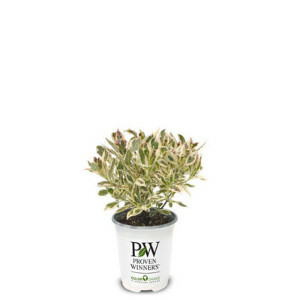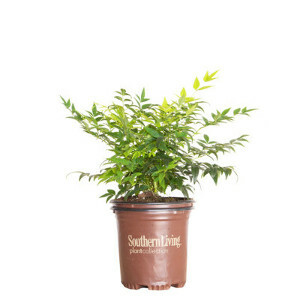
Light Needs

Mature Height

Mature Spread

Growing Zones
Medium green leaves, have bright yellow variegation combined with red stems, it is the addition you’ve been looking for! The Kaleidoscope Abelia is a great plant if you are looking for year around color. This easy to care for is compact, which makes it even more versatile. It makes a great addition to landscapes that are looking for color.
The foliage on the Kaleidoscope Abelia is interesting as it is sophisticated. Its medium green leaves have sunny yellow variegation. Add the foliage to its red stems and you have a kaleidoscope of color all year long. The Kaleidoscope Abelia attracts pollinators, with its petite blooms that appear in the summer and last until the beginning of fall. This Abelia grows to be twenty-four to thirty inches tall and thirty-six to forty-two inches tall. Plant the Kaleidoscope Abelia for its dramatic foliage and year around color. Other uses include hedge planting, mass planting, ground cover, and border planting. It thrives on hillsides and can be used as a filler in containers.
Kaleidoscope Abelia Care
This Abelia should be planted in full to part sun. It needs a minimum of four hours of sun per day. Water needs are average and should be watered more often in times of drought or extreme heat. Soil should be well drained and enriched. Soil Ph should be acidic. If planted in colder climates, mulch in the winter. Pruning to shape can be done in the winter or early spring to shape. Controlled release fertilizer should be applied in the winter or early spring.
Kaleidoscope Abelia Spacing
Spacing for the Kaleidoscope Abelia, should be planted at minimum four feet, center on center. This spacing applies to uses such as border, mass, hedge, ground cover, or near other plants.
Kaleidoscope Abelia Plant Facts
| USDA Hardiness Zones: 6-9 |
| Flower Color(s): White |
| Bloom Period: Spring to Fall |
| Foliage Color(s): Variegated |
| Light Exposure: Partial Shade to Full Sun |
| Height: 2-2.5 Feet |
| Spread: 3-3.5 Feet |
| Habit: Compact |
| Watering: Medium |
| Features: Disease/Pest Resistance, Drought Tolerant, Deer Resistant, Winter/Fall Foliage Color |
| Scientific Name: Abelia x grandiflora 'Kaleidoscope' PP16988 |
| Common Name: Kaleidoscope Abelia |
| Brand: Southern Living Plants |
Simple Plant Spacing Calculator
Please Note: The pictures below are to give a general representation of the different container sizes. The actual size/ages of plants are estimates and will vary based on type of plant, time of year, last pruning & many other factors.

Also Known As:
Quart
Plant Age:
~ 6 months - 1 year
Plant Size:
~ 4"-8"
Pot Size:
~ 4.75"H x 4.5"W
Volume:
1.50 quarts

Also Known As:
2.5 Quart Pot
Plant Age:
~ 1 - 2 years old
Plant Size:
~ 8"-12"
Pot Size:
~ 6.5"H x 6.5"W
Volume:
2.20-2.30 quarts

Also Known As:
#1 Container
1 Gallon
Plant Age:
~ 1 - 2 years old
Plant Size:
~ 10"-14"
Pot Size:
~ 7"H x 7.75"W
Volume:
2.26-3.73 quarts

Also Known As:
#2 Container
2 Gallon
Plant Age:
~ 1.5 - 3 years old
Plant Size:
~ 12"-18"
Pot Size:
~ 9.5"H x 9.5"W
Volume:
1.19-1.76 gallons

Also Known As:
#3 Container
3 Gallon
Plant Age:
~ 2 - 4 years old
Plant Size:
~ 12"-30"
Pot Size:
~9.5"H x 11"W
Volume:
2.32-2.76 gallons

Also Known As:
#5 Container
5 Gallon
Plant Age:
~3-4 years old
Plant Size:
~ 20" - 60"
Pot Size:
~11" H x 10 1/2” W
Volume:
3.5 - 4 gallons

We stand behind our plants with industry-leading guarantees to give you peace of mind.
We want your plants to arrive in great condition! If you notice any issues upon delivery, contact us within 3 days.
Starting January 1, 2026 all bushes, perennials & trees purchased come with an extended 1-year warranty for added confidence. If your plant dies due to a health issue within a year, we’ll make it right.

Pre-ordered plants are scheduled to ship in Spring 2026. We carefully plan our shipping dates based on your USDA Plant Hardiness Zone to ensure optimal planting conditions upon arrival. Want it sooner/later? Reach out, and we'll try our best to accommodate.
Estimated ship week for pre-ordered plants will ship based on growing zones as shown below.
| Growing Zone | Estimated Ship Week |
|---|---|
| Zone 10 | March 30th |
| Zone 9 | March 30th |
| Zone 8 | April 6th |
| Zone 7 | April 13th |
| Zone 6b | April 20st |
| Zone 6a | April 27th |
| Zone 5b | May 4th |
| Zone 5a | May 11th |
| Zone 4 | May 18th |
| Zone 3 | May 25th |
Note: These are only estimated ship dates. Plants may ship out later depending on weather & growing conditions of the plant.
Note: Only plants indicated as pre-order will ship as shown above. All other plants and hard goods will ship as normal.
Plants that are currently in stock typically ship within 2-7 business days after your order is placed.
Plant Addicts ships to the lower 48 states within the U.S. Unfortunately, we do not currently ship to Alaska, Hawaii, or internationally.
This plant cannot be shipped to the following states: AK, HI. These restrictions apply only to this specific plant due to agricultural regulations or other limitations. Other plants may still be available for shipping to these states.
If you have any questions about shipping restrictions, feel free to reach out to our team!


















